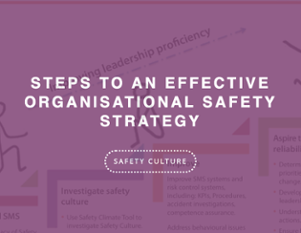 As all health and safety professionals know, a positive safety culture is good for your business, not only from an ethical standpoint, but also in terms of productivity and efficiency.
As all health and safety professionals know, a positive safety culture is good for your business, not only from an ethical standpoint, but also in terms of productivity and efficiency. But how do you convey that to the decision-makers within your organisation, to allow you to invest in resources to measure your safety culture, and improve it?
Decision-makers are usually motivated by one of three arguments: legal, moral and financial. If you’re advocating for a better safety culture in your organisation, you should be armed with information that falls into each of these categories.
Legal
Under the WHS Act, employers have a legal obligation to ensure that the health and safety of their workers is protected, and by law they must have policies and systems in place to ensure this. Failure to do so can result in hefty fines — or even jail time if the negligence is severe enough.
The aim is to provide all workers in Australia with the same standard of health and safety protection regardless of the work they do or where they work. The WHS Act provides a framework to protect the health, safety and welfare of all workers at work and of other people who might be affected by the work.
This is important information for key decision-makers as it emphasises that creating a safety culture is a legal obligation, not a token gesture.
Moral
As an employer, your employees trust you to create a workplace where they can perform their work without fear of becoming ill, seriously injured, or worse. Employers have a moral duty to do all they can to protect health and safety at work.
The vast majority of people and employers don’t set out to intentionally harm others or put them in danger. Yet poor health and safety can result both in injuries and ill health, and sometimes even in death. Workers who face poorly controlled risks to their health and well being at work are unlikely to be satisfied and content, and may not work to their full capacity.
Sadly, there are too many stories of people who have been seriously injured while at work, or even killed. The families, friends and colleagues are left behind to deal with the consequences. Their stories are the perfect example why employers should do their utmost to uphold the highest standards of health and safety in the workplace.
Financial
The costs associated with improving workplace safety culture should be seen as an investment. When you consider that workplace injuries cost the Australian economy $61 billion per year, investing in workplace safety makes good business sense.
Research shows that weak safety culture has a direct impact on the number of injuries suffered by workers, by up to 30%.
Conversely, several other reports show a strong organisational safety culture is associated with reduced risk taking behaviour by workers, and fewer injuries. This is partly because organisations with strong safety cultures tend to have made the financial investments to develop effective health and safety management systems.
Accidents at work are costly to your business. Whether it’s a fatality or something relatively minor, there is a significant business cost involved. And it’s not just the direct costs that can be significant. Anyone who’s ever had to deal with such an incident will tell you about the paperwork involved, the time spent on the phone liaising with insurers and lawyers, the costs of hiring additional staff, or not having enough staff, not to mention the damage to your reputation as an employer.
Online Safety Climate Survey
The Safety Climate Tool Survey is a powerful new product to Australia that explores your employees' attitudes and perceptions in key areas of health and safety. The survey then produces a detailed report that provides hints and tips that help you improve your organisation's safety culture.
Using a simple, online questionnaire that staff can complete anonymously, the survey promises to be a tool that can help shape your organisation’s approach to workplace safety. Review our services.



